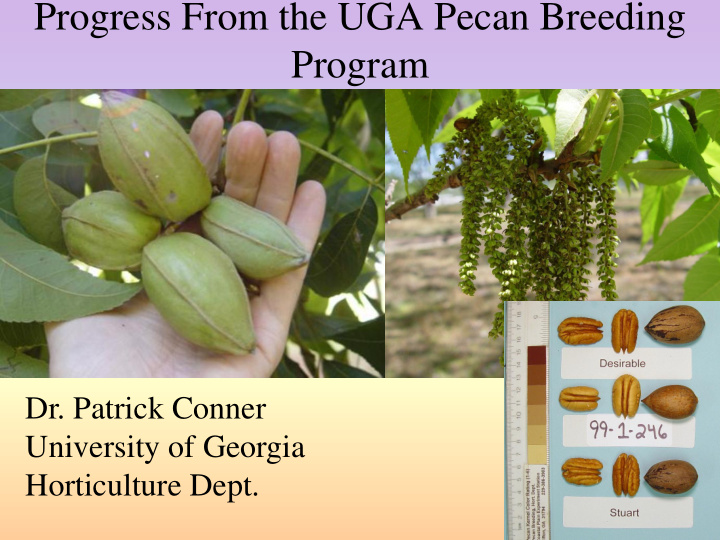



Progress From the UGA Pecan Breeding Program Dr. Patrick Conner University of Georgia Horticulture Dept.
An Example: The Life Story of Ga. 00-7-75 The cross was „Gloria Grande‟ x „Barton‟, the 7 th cross made in 2000 (00-7), one of 16 different crosses made that season. Since 1999 we have made 233 different crosses, utilizing 88 different cultivars as parents. Most prominent parents: „Desirable‟, „Pawnee‟, „Elliott‟, „Oconee‟, „Barton‟. We average about 15 crosses a year, it goes up and down with „Off‟ and „On‟ year cycles. Dr. Patrick Conner
The Start: Making the Cross 150 clusters of „Gloria Grande‟ were bagged and pollinated with „Barton‟ pollen. Out of those pollinations we collected 141 seed. We average about 1 nut per bag applied. Dr. Patrick Conner
Growing the Tree: Planting The seed from cross 00-7 was planted in the ground in a seedling nursery in 2001. All crossed together that year‟s crosses produced 1,975 seed. In the 16 years we have been crossing pecans we have produced about 27,00 seed. The 141 seed from 00-7 produced 81 trees, we typically get about 60% of the seed to produce vigorous seedlings, varies widely depending upon the mother tree. Dr. Patrick Conner
We now plant seedlings in pots to facilitate scab screening in the first year. • Screen for foliar resistance to pecan scab. • Up to 80% elimination of some progenies. Dr. Patrick Conner
Growing the Tree: Transplanting The year 2000 progenies spent 2 years in the nursery before being planted in the progeny field in the spring of 2003. Potted trees now spend 1 year in a pot and are planted in the progeny field the next year. Dr. Patrick Conner
Growing the Tree: First Fruit Ga. 00-7-75 produced its first crop of nuts in 2007, its 7 th year of growth, 5 years after transplanting. First fruiting season is generally in years 7-9, six years is the earliest we have fruited something. Seedlings take longer than grafted trees to fruit because they go through a juvenile period. Dr. Patrick Conner
Making a Selection We watched Ga. 00-7-75 for only 2 years before topworking it into or trial orchard. When something is propagated for further trials it goes from being a “seedling” to a “selection”. We have topworked a few selections, but mostly we have had to graft young trees, which take longer to fruit. Dr. Patrick Conner
Trialing the Selection: Station Yield Trials Topworked trees began fruiting in 2011, the third year from topworking. Yields are approaching that of unworked trees. How much yield data is enough to release? Dr. Patrick Conner
Trialing the Selection: Off-Campus Trials Off-Campus trials of Ga. 00-7-75 Shiloh Farms: 17 trees planted in 2012 SE Georgia Pecan Nursery: 14 trees planted in 2014 NILO Plantation: Will topwork several trees in 2015 Hampton Pecan Nursery: Will graft trees for trial in 2015 Linwood Nursery: Will graft trees for trial in 2015 We hope to expand this type of testing in the future. Dr. Patrick Conner
Trialing the Selection: Scab Resistance Trials Unsprayed trial at various locations. Ponder Farm, Tifton Ga. NILO Plantation, Albany, Ga. Ga. 00-7-75 has not UGA Attapulgus station. scabbed at any location. „Sumner‟ has had moderate scab in these tests. Dr. Patrick Conner
Road to Release: Review Teams Pecan cultivar recommendation committee: Made up of prominent pecan growers, scouts, shellers, and nursery owners. Meets annually in Sept. to tour plots and evaluate nuts. UGA cultivar release committee: Made up of 4-5 breeders from UGA. Agronomists weight heavily towards having replicable yield data. Meets biannually. Dr. Patrick Conner
In the Pipeline: 23 Selections now in trials. Year Female Male Nuts % Harvest UGA Shiloh NILO SE GA season y Scab z Selection Entered parent parent / lb. Kernel trees trees trees trees 00-7-75 2009 Gloria Barton 47 53 EM-M N 4 17 14 99-2-28 2009 Elliott Oconee 53 57 EM S-M 8 17 6 01-10-6 2014 Sumner Elliott 49 58 ML N 5 26 00-10-32 2014 Forkert Jackson 54 59 EM M 5 00-9-10 2014 Forkert Caddo 54 56 EM M 5 00-13-5 2014 Barton Jackson 53 56 E-EM N 5 31 03-6-72 2014 Sioux Desirable 51 62 M M-H 5 20 99-1-246 2014 Elliott Desirable 54 58 M N 5 23 5 17 99-2-108 2010 Elliott Oconee 50 58 EM-M S 8 17 6 6 03-3-31 2014 Brooks Desirable 60 55 M-ML S 5 19 01-23-11 2014 Jenkins O.P. 60 53 E-EM N-S 5 00-14-45 2014 Barton Caddo 62 60 E-EM S 5 24 02-5-144 2014 Sumner Pawnee 54 58 ML N 5 00-14-46 2015 Barton Caddo 51 59 EM M-H 03-8-33 2014 Schley Desirable 51 54 EM M-H 5 99-6-38 2014 Barton Elliott 55 59 EM N 5 03-6-32 2009 Sioux Desirable 46 56 EM-M M-H 4 17 5 18 04-5-34 2012 Melrose 70-6-15 61 55 E-EM N 3 99-9-3 2010 Elliott Pawnee 58 57 EM M-H 1 17 03-1-20 2014 Chickasaw Jackson 57 55 E M 5 99-2-15 2010 Elliott Oconee 59 59 EM M-H 4 11 04-8-7 2014 70-6-15 Sioux 50 57 EM-M M 19 03-7-13 2012 Kicklighter Shoshoni 60 62 E M 3
This work was generously funded by the Georgia Pecan Commodity Commission ….Thank You! Dr. Patrick Conner
Recommend
More recommend